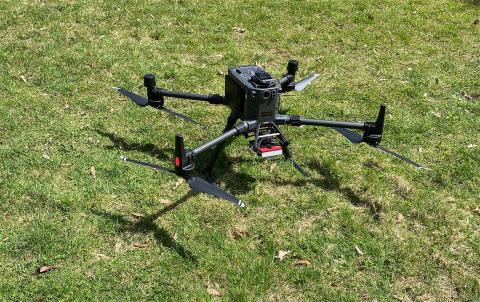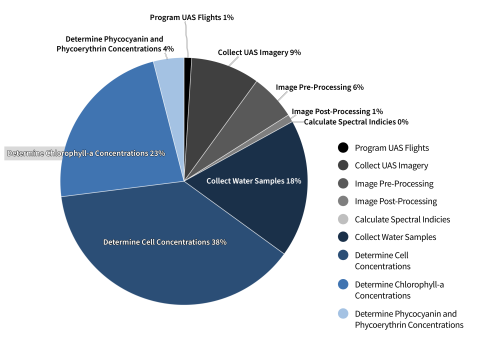This research was published in the INSPIRED: A Publication of the New Hampshire Agricultural Experiment Station (Spring 2024)
Researchers: C. Bunyon, B. Fraser, A. McQuaid & R. Congalton
Billions of years ago, cyanobacteria were crucial to some of Earth’s first lifeforms that produced oxygen and helped form the planet’s atmosphere. More recently, a changing climate has led to increases in toxic blue-green algae blooms of cyanobacteria in New Hampshire lakes—popular summer getaways for Granite Staters and visitors, and important economic drivers for the state. Traditional monitoring of these blooms involves time-consuming water sampling and testing that can also expose environmental specialists to potential health risks. To overcome these challenges, the UNH Basic and Applied Spatial Analysis Lab developed a promising alternative for identifying aquatic cyanobacteria blooms—using unpiloted aerial systems, or drones, to identify cyanobacteria outbreaks, and their concentration levels, using spectral imaging data.
Cyanobacteria and Harmful Algal Blooms
Cyanobacteria, commonly known as blue-green algae, are a group of bacteria that obtain their energy through photosynthesis. They are known for their ability to thrive in various water bodies, including freshwater lakes, where they can form visible colonies known as algal blooms.
Some species of cyanobacteria produce toxins harmful to aquatic life, pets, livestock, and humans, leading to what are termed harmful algal blooms (HABs). These blooms can adversely affect water quality, ecosystem stability, and public health. Historically, monitoring and identifying cyanobacteria blooms has relied on the collection of lake water samples followed by laboratory analyses to determine cyanobacteria concentration. These methods, while effective, are labor- and time-intensive and can pose risks to researchers.
Recent advancements in remote sensing and aerial survey technologies have presented new opportunities for monitoring environmental phenomena, but little research has focused on using unpiloted aerial system (UAS) technology.
Methodology
Key Findings
- Multispectral sensors on an unpiloted aerial system (UAS) proved over 90 percent effective in detecting cyanobacteria blooms—also known as harmful algal blooms—in New Hampshire lakes.
- Relative to traditional water sampling methods, UAS monitoring reduces time and labor for monitoring, minimizes health risks to researchers and provides a more comprehensive understanding of water quality dynamics in real-time.
About the Co-author

Russel Congalton, Professor Emeritus, UNH College of Life Sciences and Agriculture
Contact information: Russ.Congalton@unh.edu

Fig. 2. DJI Matrice 300 RTK drone.
Researchers repeatedly assessed six New Hampshire lakes between May and September 2022 (Fig. 1). At each lake on each visit, a DJI M300 RTK drone (Fig. 2) with a MicaSense 10-band dual camera system was flown to collect multispectral imagery.
Following image collection, water samples were collected at selected locations within the lake by a researcher in a canoe. The samples were collected following the flight so that the imagery collection was not disturbed by the movement of the canoe through the water.

Fig. 1. Map showing study sites across New Hampshire, including ponds and lakes monitored for cyanobacteria concentrations and water quality using advanced sampling techniques. Credit: Christine Bunyon, M.S. Thesis, May 2023
Water samples were analyzed at the UNH Water Quality Analysis Lab to determine the concentrations of cyanobacteria in the water. Sample results were combined with the multispectral imagery to assess using a random forest digital image classification algorithm to determine if the imagery could accurately predict cyanobacteria concentrations.
Results and Impacts
The methods achieved high overall classification accuracies for detecting cyanobacteria cell concentrations (93%), chlorophyll-a (87%), and phycocyanin levels (92%) from the remotely sensed imagery. These results demonstrate the potential of using UAS technology as a rapid, safe, and efficient tool for monitoring algal blooms in freshwater systems.

Fig. 3. Approximate comparison of the amount of time to complete tasks. Blue sections represent those associated with the collection and processing of water quality parameters. Grayscale sections represent those associated with the collection and processing of UAS parameters. Traditional water quality tasks took roughly 310 hours to complete while UAS tasks took roughly 65 hours to complete. Credit: Christine Bunyon, M.S. Thesis, May 2023
The research also highlighted the utility of specific spectral indices and wavelengths—for example, the 475 nm wavelength and normalized green-blue/red difference indices—in identifying cyanobacteria blooms. By providing a more immediate and detailed view of water quality conditions, UAS technology can assist environmental managers in making informed decisions, which are critical for long-term protection of public health and aquatic ecosystems (Fig. 3).
Additionally, there were valuable insights into the capabilities of using UASs for environmental monitoring and offer a model for similar research efforts in other regions. As cyanobacteria blooms become an increasingly significant concern due to climate change and nutrient runoff, the application of advanced monitoring technologies like UAS will be critical in safeguarding water resources and public health.
This material is based on work supported by the NH Agricultural Experiment Station through joint funding from the USDA National Institute of Food and Agriculture (under McIntire-Stennis award number 1026105) and the state of New Hampshire.
